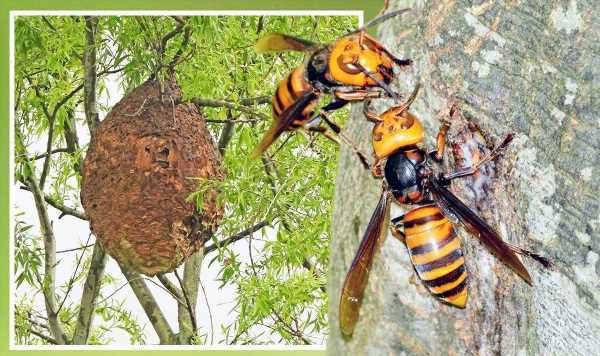Asian giant hornets: Researchers open nest in Washington
We use your sign-up to provide content in ways you’ve consented to and to improve our understanding of you. This may include adverts from us and 3rd parties based on our understanding. You can unsubscribe at any time. More info
Asian hornets are a non-native species which prey on honey bees and other pollinators. This dangerous creature can cause significant losses to bee colonies and several other ecosystems, but what exactly do they look like? Spotting the difference between a regular and giant hornet is easier to do when you know what to look for – and these are the main characteristics to remember.
The Asian giant hornet – also known as the yellow-legged hornet, has become more prominent in the UK since 2016.
This damaging creature is listed by the Non-native Species Secretariat, which states that the hornet is active mainly between April and November – often reaching its peak during August and September.
The Secretariat said: “It is important to report any suspected sightings of this species as soon as possible.
“Vigilance is particularly required in southern parts of England and Wales and around major ports.”


How to spot a giant hornet
The Animal and Plant Health Agency has identified four key characteristics of the Giant Asian Hornet which may make them easier to tell apart from ordinary hornets.
Yellow tipped legs
This six-legged creature is known for its yellow-tipped legs which brighten up the mostly dark appearance.
Giant hornet legs are brown at the point where they join the body, while the very ends are a vibrant yellow hue.

Entirely black or brown body
The yellow-legged hornet can be identified by its dark abdomen which is detailed with just one yellow stripe.
According to the National Bee Unit, the Asian giant hornet has an “entirely black and velvet thorax and orange head”.
The ‘giant’ species is usually between 25-30mm long.
A deep buzzing sound
This dangerous hornet species can be heard as well as seen. Just listen out for a deep, low-toned buzz.
DON’T MISS:
How to water your roses – 4 top tips to help your roses thrive [INSIGHT]
What to prune in May – four plant types to trim for spring [REVEAL]
When to plant out bedding plants – best time to get planting [ANALYSIS]

Banding on the fourth segment of the abdomen
Yellow-legged hornets are easy to identify by the position of the orange strip which covers one end of the creature.
The British Beekeepers Association states that this is always on the fourth segment of the dark abdomen.
If there is more than one orange segment on the hornet, it is unlikely to be an Asian giant hornet.
Instead, it is likely to be a European hornet which has multiple yellow segments on its brown abdomen.
How common are Asian giant hornets in the UK?
This non-native species originated in Asia and was accidentally introduced to France in 2004.
Since 2016, sightings of this dangerous hornet rapidly increased in the UK, though most are spotted in the warmer months, often during summer.
The invasive nature of the giant hornet means that any suspected sightings must be reported, and the first sighting of the year has already been confirmed.
According to the British Beekeepers Society, a single Asian hornet was spotted in the shed of a beekeeper in Felixstowe, Suffolk at the very end of April 2022.
According to gov.uk data, there have been 22 sightings of the giant hornet in the UK since 2016.
Further sightings can be reported via the Asian Hornet Watch app.
Source: Read Full Article
